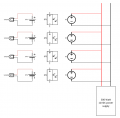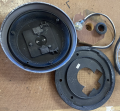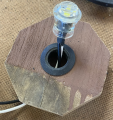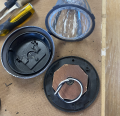Ok, so I am a former US Navy Electronics Tech (37 years ago) and I do remember most of my training but I work in IT / Cloud computing so this is not something I do every day. This is really just a hobby project so be patient with me.
1) I have purchased these fence lights and they work really well when they get full sun. However my backyard in certain areas doesn't always get enough sunlight and some lights will only work for a short period of time and then will turn off.
2) The lights have a nice battery, a good little PV panel and are very serviceable. A few screws and you can pop out the battery and access the control board as well.
3) My idea was to purchase this 300 watt DC power supply and have it do the following:
I am using these connectors to wire in an IP68 connector to the fence light.
I will end up with about 22 of these small LED fence lights on one of the three legs of the 300 watt power supply. I have another leg of about 18 lights down the other fence line I am looking to install the same lights.

Any help is appreciated.
1) I have purchased these fence lights and they work really well when they get full sun. However my backyard in certain areas doesn't always get enough sunlight and some lights will only work for a short period of time and then will turn off.
2) The lights have a nice battery, a good little PV panel and are very serviceable. A few screws and you can pop out the battery and access the control board as well.
3) My idea was to purchase this 300 watt DC power supply and have it do the following:
a. Provide power to the battery to charge in the event enough solar energy was not available.
b. I expect that with DC power provided directly to charge the battery, it wouldn't take long to get a full charge.
c. Have some way of measuring the current charge of the battery and if the current charge state was below a given threshold charge the battery fully and then open a relay to remove power.
4) I don't know if I need some type of small charge controller or not I would expect that if I used one, the life of the system components would be extended.I am using these connectors to wire in an IP68 connector to the fence light.
I will end up with about 22 of these small LED fence lights on one of the three legs of the 300 watt power supply. I have another leg of about 18 lights down the other fence line I am looking to install the same lights.

Any help is appreciated.



















